Kristine Hughes's Blog, page 62
March 20, 2016
DO YOU KNOW ABOUT - THE SHIPPING FORECAST?
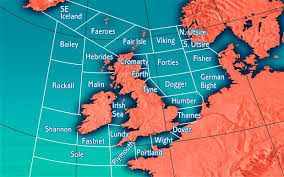
The BBC's Shipping Forecast has been broadcasting coastal weather conditions to its listeners for over 150 years and its loyal following extends far beyond mariners. Fans of the television show As Time Goes By will be aware that Mrs. Bale, the Hardcastle's housekeeper at their country home, stops everything in order to listen the Shipping Forecast. In Keeping Up Appearances, Hyacinth Bucket consults the Shipping Forecast before she and Richard go boating - even though their sail will only follow the inland Thames. In addition, the Shipping Forecast has inspired music, literature and art. Heck, my online friend and fellow blogger Scott Lyman even named his blog The Shipping Forecast.
So . . . . just what is the Shipping Forecast?
From Wikipedia:
The Shipping Forecast is a BBC Radio broadcast of weather reports and forecasts for the seas around the coasts of the British Isles. It is produced by the Met Office and broadcast by BBC Radio 4 on behalf of the Maritime and Coastguard Agency. The forecasts sent over the Navtex system use a similar format and the same sea areas. The waters around the British Isles are divided into 31 sea areas, also known as weather areas (see map below)[1] There are four broadcasts per day at the following (UK local) times:0048 – transmitted on FM and LW. Includes weather reports from an extended list of coastal stations at 0052 and an inshore waters forecast at 0055 and concludes with a brief UK weather outlook for the coming day. The broadcast finishes at approximately 0058.0520 – transmitted on FM and LW. Includes weather reports from coastal stations at 0525, and an inshore waters forecast at 0527.1201 – normally transmitted on LW only.1754 – transmitted only on LW on weekdays, as an opt-out from the PM programme, but at weekends transmitted on both FM and LW.The unique and distinctive sound of these broadcasts has led to their attracting an audience much wider than that directly interested in maritime weather conditions. Many listeners find the repetition of the names of the sea areas almost hypnotic, particularly during the night-time broadcast at 0048 UK time.In October 1859, the steam clipper Royal Charter wrecked in a strong storm off Anglesey; 450 people lost their lives. Due to this loss, Vice-Admiral Robert FitzRoy introduced a warning service for shipping in February 1861, using telegraph communications. This remained the United Kingdom's Met Office primary responsibility for some time afterwards. In 1911, the Met Office had begun issuing marine weather forecasts which included gale and storm warnings via radio transmission for areas around Great Britain. This service was discontinued during and following World War I, between 1914 and June 1921, and again during World War II between 1939 and 1945.[2]Today, although most ships have onboard technology to provide the Forecast's information, they still use it to check their data.The last broadcast of the Shipping Forecast at 0048 each day is traditionally preceded by the playing of "Sailing By", a light orchestral piece by Ronald Binge. This is only very rarely omitted, generally when the schedule is running late. Though occasionally played in full, it is common for only a section of the piece to be broadcast; that section being the length required to fill the gap between the previous programme's ending and the start of the forecast at precisely 0048.[8] More importantly, Sailing By serves as a vital identification tool – it is distinctive and as such assists anyone attempting to tune in. The forecast is then followed by the National anthem and the closedown of the station for the day, with the BBC World Service taking over the frequencies after the pips of the Greenwich Time Signal at 0100.
You can listen to a broadcast of the Shipping Forecast here.
Alternately, here's Stephen Fry's cheeky take on the shipping forecast.
Published on March 20, 2016 23:30
March 18, 2016
BEN FRANKLIN'S BONES
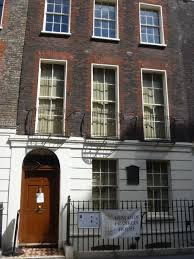
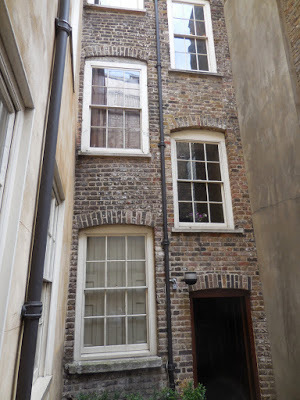
In the heart of London is Benjamin Franklin House, above, the world's only remaining Franklin home. For nearly sixteen years between 1757 and 1775, Dr Benjamin Franklin – scientist, diplomat, philosopher, inventor, Founding Father of the United States and more – lived behind its doors. Built circa 1730, it is today a dynamic museum and educational facility.
While lodging at 36 Craven Street, Franklin's main occupation was mediating unrest between Britain and America, but he also served as Deputy Postmaster for the Colonies; pursued his love of science (exploring bifocal spectacles, the energy-saving Franklin stove); explored health (inoculation, air baths, cures for the common cold); music (inventing the delightful glass armonica for which Mozart, Bach and Beethoven composed) and letters (articles, epitaphs, and his witty Craven Street Gazette), all while forging a hearty social life and close friendships with leading figures of the day.
The House, built circa 1730, is architecturally significant. It holds a Grade I listing and retains a majority of original features (central staircase; lathing; 18th century paneling; stoves; windows; fittings; beams; brick, etc) 'unimproved' over time.
Fast forward to 1998, when the first conservation work began at Craven Street. It was interrupted by the discovery of bones, both human and animal, under the floor of what is today the House’s Seminar Room (originally the garden in Franklin’s day). The London coroner was called and he determined that the bones were more than 100 years old so no inquest was needed.
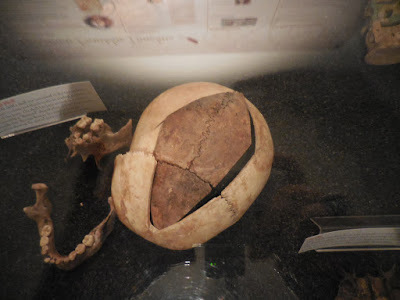
Display Label: This cabinet displays a selection of the bones found ten years ago in the basement of the house. They are the result of William Hewson' anatomy school, which opened here at 35 Craven Street on the 30 September, 1772. They are being shown here for the first time since their discovery. Although this is only a small collection of the original number of bones found, the specimens selected for display are of particular medical interest.
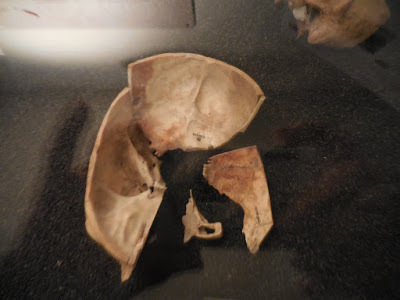
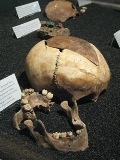
The Craven Street Bones on display in the Seminar Room
Consequently, the House team invited Dr. Simon Hillson and colleagues from London’s Institute of Archaeology at University College London to study the bones and their research has provided valuable historical details.From a one metre wide, one metre deep pit, over 1200 pieces of bone were retrieved and are the the remnants of an anatomy school run from the House by William Hewson, son-in-law of Franklin’s landlady, Margaret Stevenson. Hewson, who married Margaret’s daughter Polly in 1770, is best known for his research on blood and the lymphatic system. He isolated the key protein in the blood clotting process, fibrinogen, and called it “coagulable lymph.”
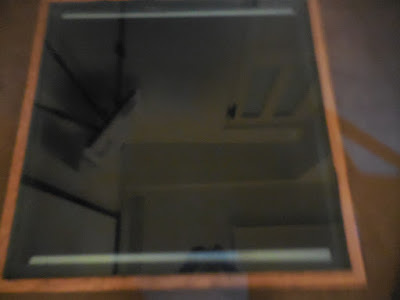
A glass viewing window in the basement allowing visitors to see where the bones where discovered
Hewson trained in Edinburgh and studied with famous anatomist William Hunter, becoming a partner in Hunter’s school at Great Windmill Street, London. Hewson had a falling out with Hunter and Franklin served as a mediator. Franklin noted, “I should think it no Trouble to hear their Complaints if I could be of the least Use in accommodating their Differences; but since that was not likely, I could only wish as I had a Regard for both, that they would go on to the End of their Term as quietly as possible, since that would be most to the Credit of both.”
In due course, Hewson opened his own anatomy school at Craven Street. The human remains derive from over 15 people and show dissection marks from surgical instruments (animal remains were found primarily in the front of the House in the old coal depositories). For example, a femur bone has been cut cleanly probably demonstrating the process of amputation. This was a valuable skill when there was little knowledge of sterilisation and much diplomacy took place on the battle field! The skull pieces have circles drilled out from a trepanning device – a sample of one is on display in the Seminar Room. Trepanning was primarily used to relieve pressure on the brain. However, relatively few surgical operations had any likelihood of success; invasive procedures were made difficult by the possibility of major blood loss and infection, and the lack of anaesthetic, not used until 1846.
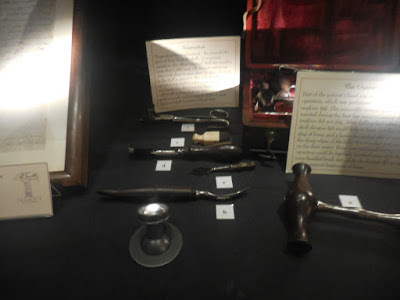
Key evidence linking the Craven Street bones to Hewson’s anatomy school is a portion of a turtle spine and mercury found in the bone pit. In an experiment conducted in 1770 at the Royal Society, Hewson showed the flow of mercury through a turtle to highlight the lymphatic system. With help from Franklin, Hewson was elected to the Royal Society and received their Copley Medal for his work. Other items linked to anatomical study were also found in the bone pit, including microscope slides.
In Georgian England, the practice of anatomical study became increasingly popular. Limited hospital teaching left a gap filled by private schools like Hewson’s. They also satisfied growing interest in public health and talks by the experts were financially successful. Despite this, procuring bodies for dissection was not easy. It did not become a fully legal practice until 1832. It is likely that some of Hewson’s cadavers came from the so-called ‘resurrectionists’ – bodysnatchers who shipped their wares along the Thames under cover of night.
Anatomy was a hazardous area of study: during a dissection in 1774 Hewson contracted septicaemia and died aged just 34. As Franklin wrote to his wife Deborah: “Our Family here is in great Distress. Poor Mrs. Hewson has lost her Husband, and Mrs. Stevenson her Son-in-law. He died last Sunday Morning of a Fever which baffled the Skill of our best Physicians. He was an excellent young Man, ingenious, industrious, useful, and belov’d by all that knew him. She is left with two young Children, and a third soon expected. He was just established in a profitable growing Business, with the best Prospects of bringing up his young Family advantageously.” Polly would eventually move with her children to Philadelphia to be close to Franklin after the close of the Revolutionary War.
To learn more, watch the complete episode of the PBS special, Secrets of the Dead: Ben Franklin's Bones here (55 minutes)
Visit the Benjamin Franklin House website here.
Read more about the history of Craven Street here.
Published on March 18, 2016 00:00
March 15, 2016
HAPPY 6TH BIRTHDAY TO NUMBER ONE LONDON


It's hard to believe that Number One London will celebrate it's 6th birthday tomorrow! And what a six years it's been - we've had over 1,535,202 visitors from across the globe, many of whom are loyal readers, with top countries including the US, UK, Canada, Germany, Australia, France, Spain, Sweden, Poland and India. Number One London is being read in such diverse locales as Israel, Iceland, Armenia, Sri Lanka, Mongolia, Uganda, Fiji and the Faroe Islands - a subarctic island group situated approximately halfway between Great Britian and Iceland. Who knew?
Including this post, we've published exactly 1,300 posts to date and have been fortunate enough to win a few awards along the way. Personally, Victoria and I have had a blast blogging, sharing our adventures and experiences and hearing from all of you. Thanks so much for your comments and emails and for sharing links to Number One London with your friends and for also following us on Facebook and Twitter. Thanks also to everyone with blogs and websites of their own who have been kind enough to include our link on their pages. We urge you to take a look at the "Amusing Blogs" link in the left-hand sidebar, where you will find some of our favourite blogs.
Since we began blogging, Victoria and I have returned to England several times, both separately and together, not least of which was for The Duke of Wellington Tour. Our tour posts always generate many comments and receive a warm reception. We're pleased to tell you that there are more tours coming soon - watch this space for details.
We'd like to thank loyal friends for your continued support and to send out heartfelt thanks to all the new friends we've made along the way. Please keep the comments coming - they allow us to channel our inner Sally Fields and to believe that you really, really like us.
And lest we forget . . . .
Happy St. Patrick's Day!
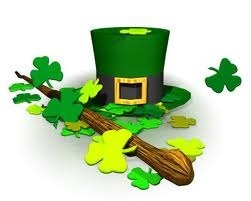
Published on March 15, 2016 23:30
March 13, 2016
THE WELLINGTON TOUR: THE HORSES
IN LONDON
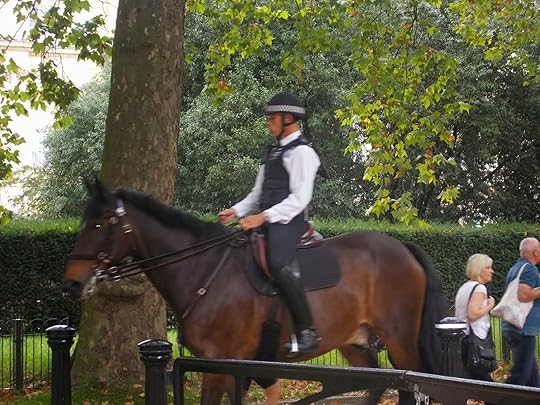
Seen in the Mall
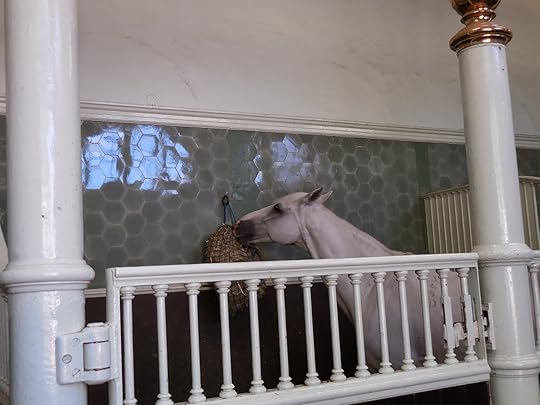
Above and below - In the Royal Mews
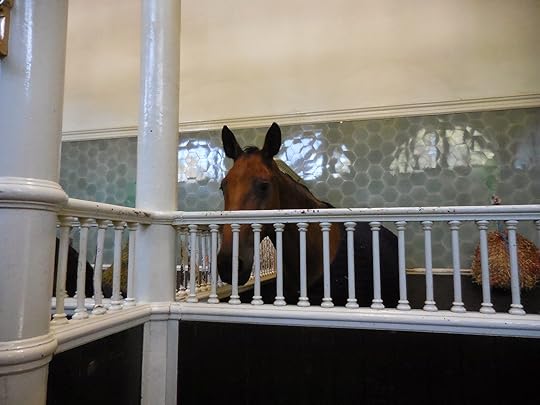
From our vantage point atop the Wellington Arch

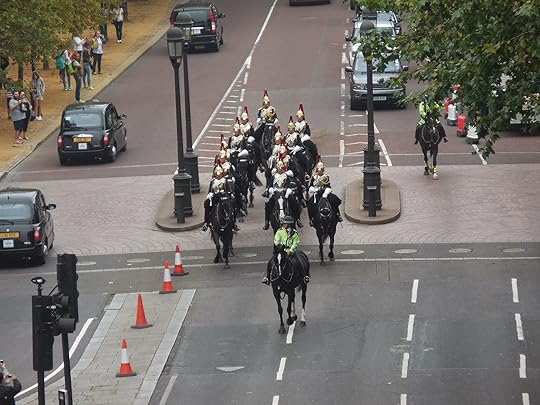
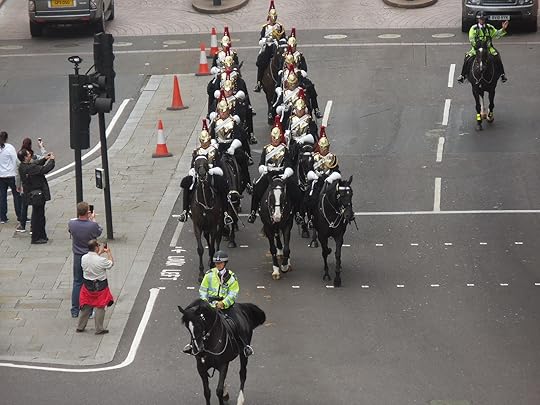
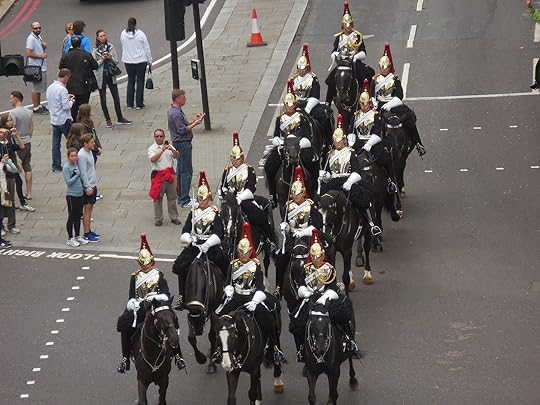
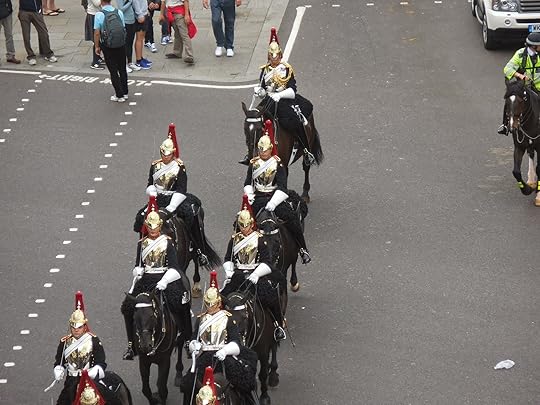
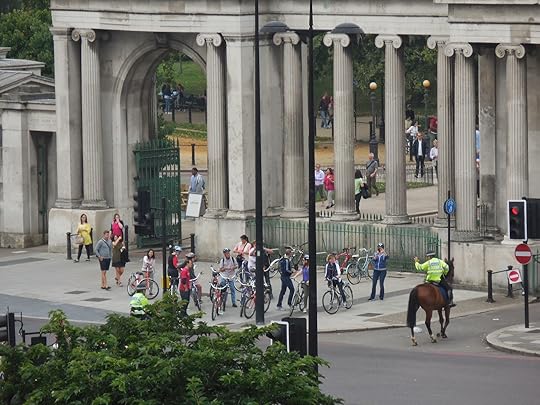
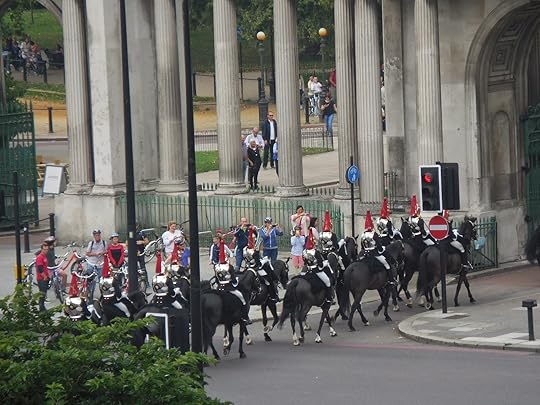
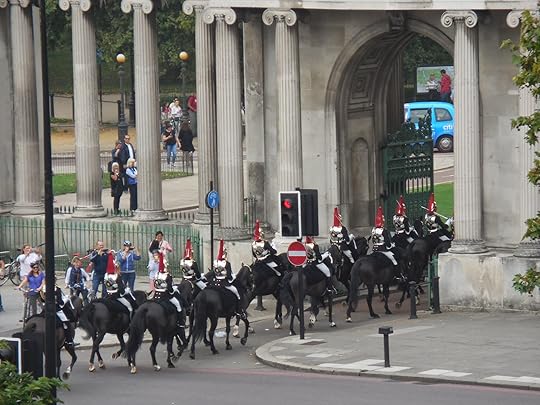
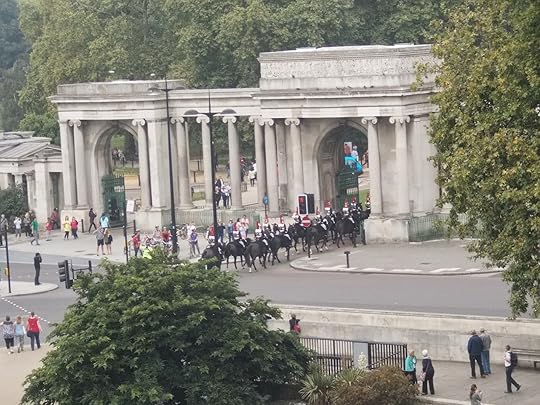
As seen at Horseguards
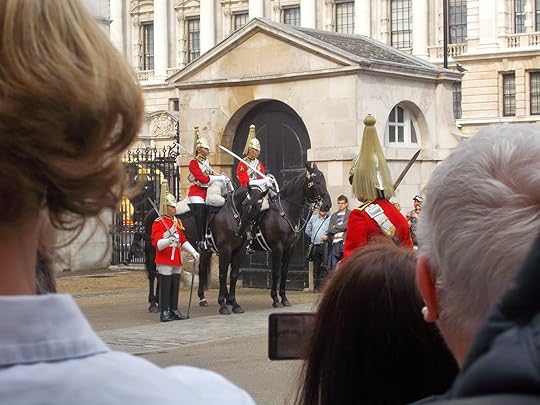
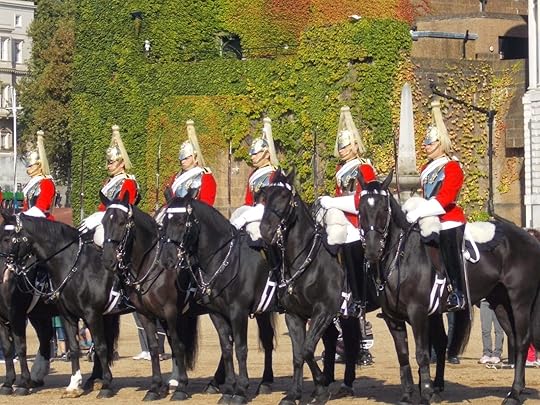
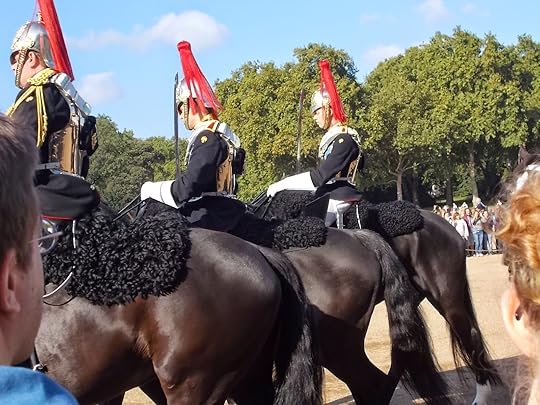
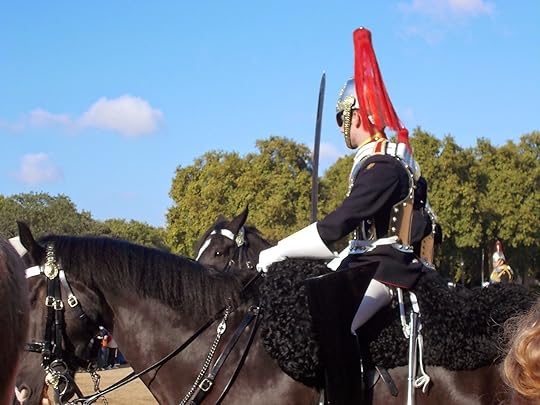
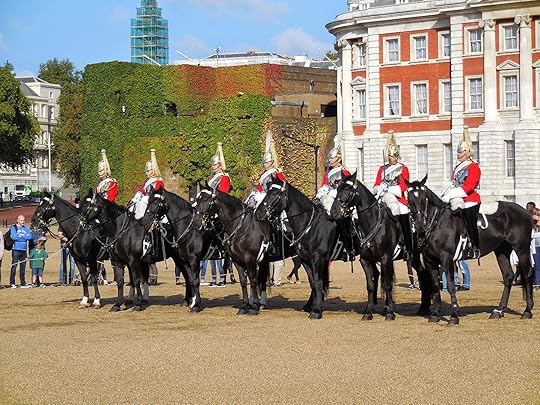
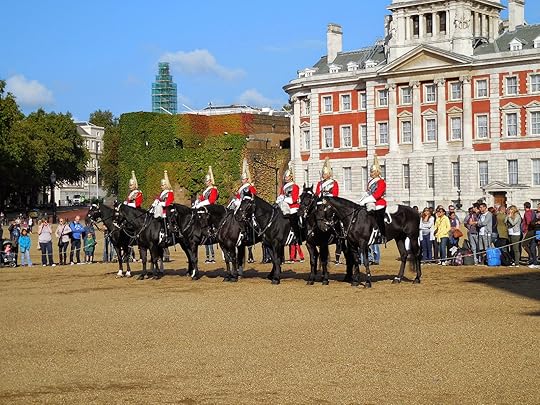
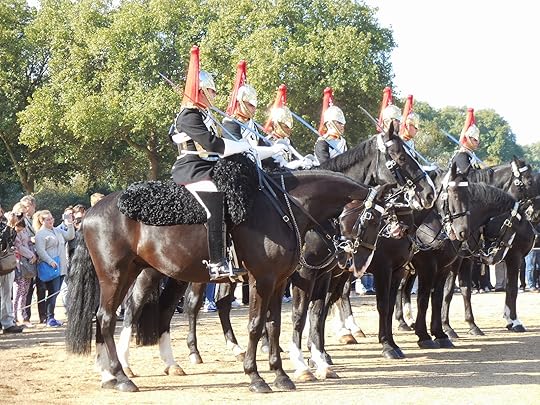
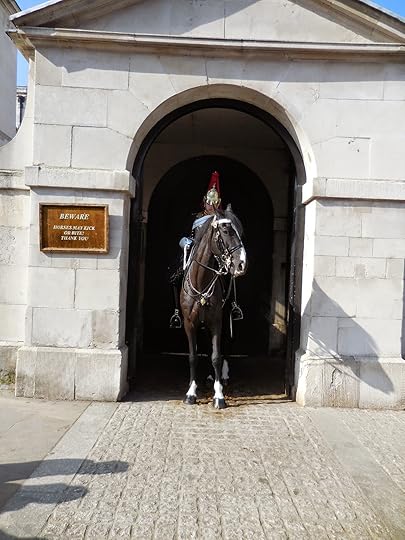
At Osterley Park

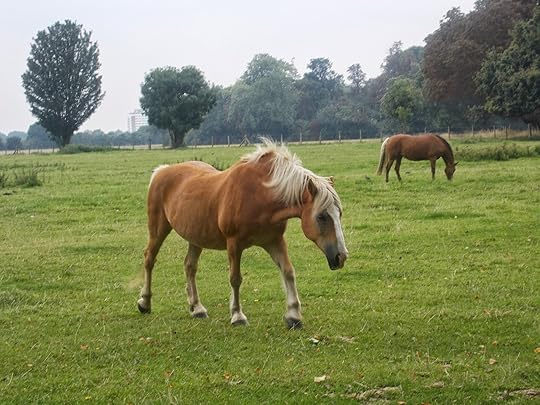

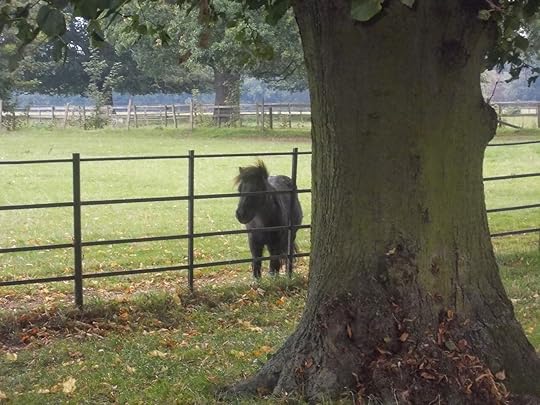
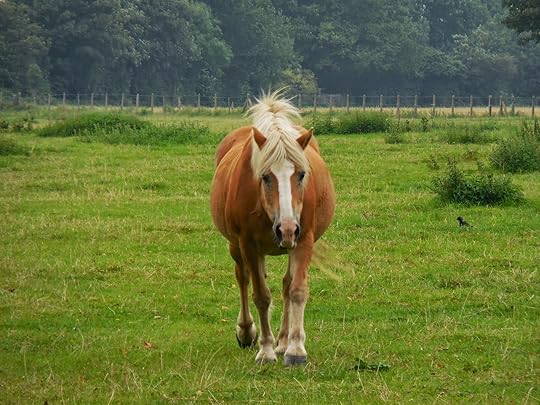
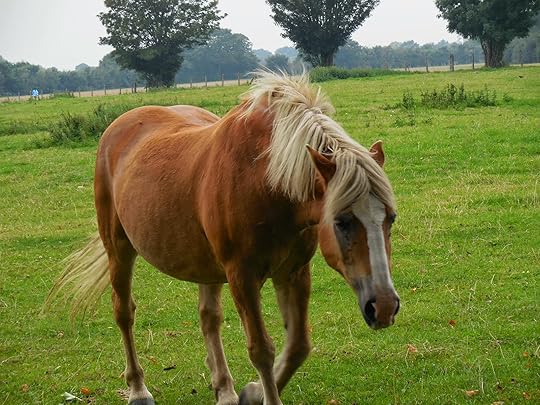



STRATFIELD SAYE
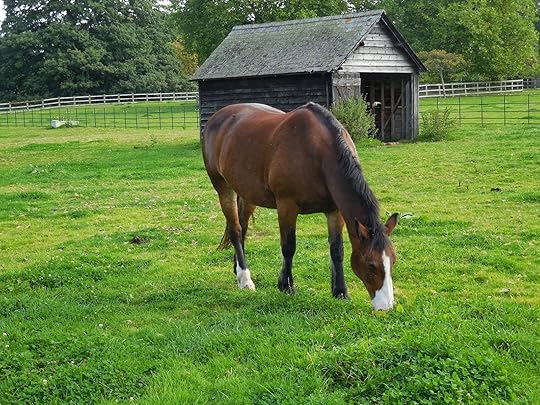
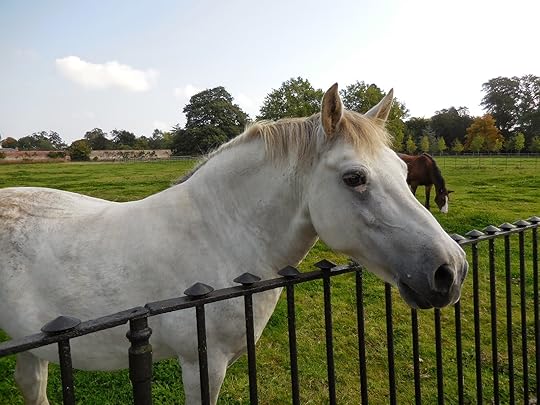
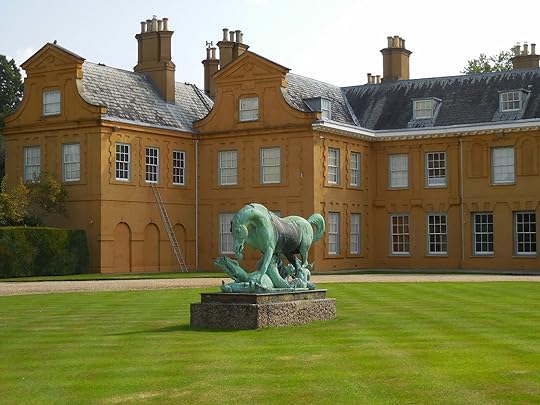
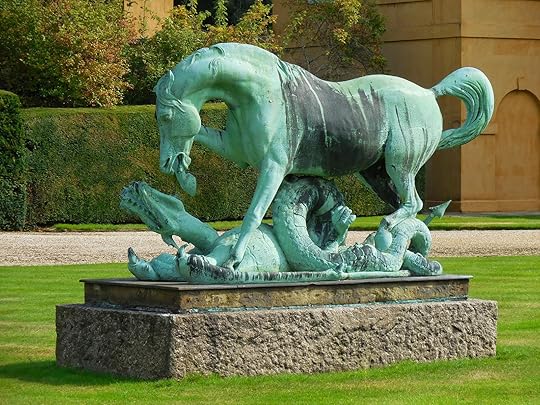
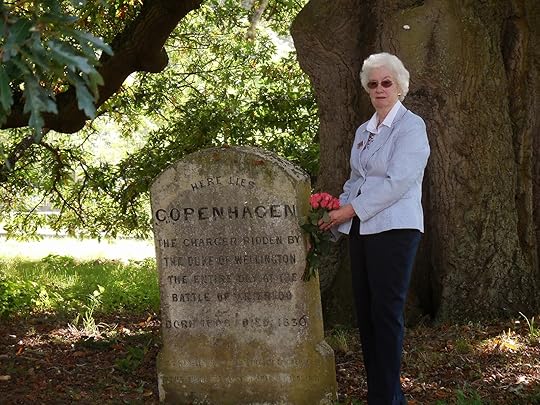
IN WINDSOR


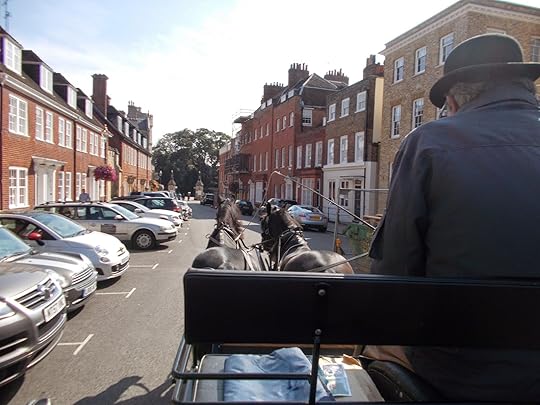
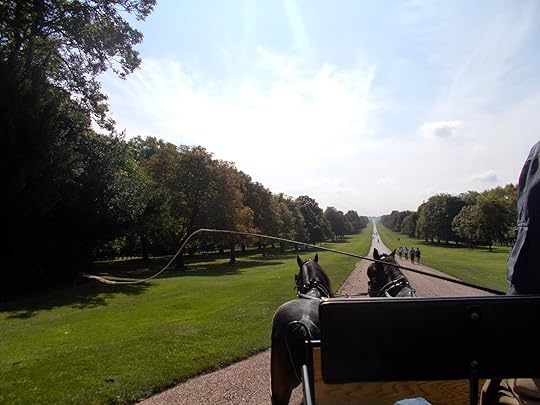
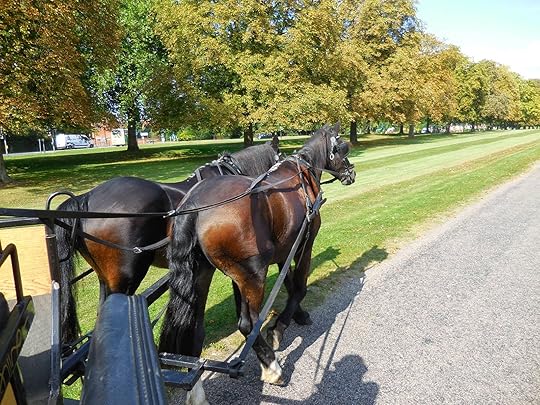
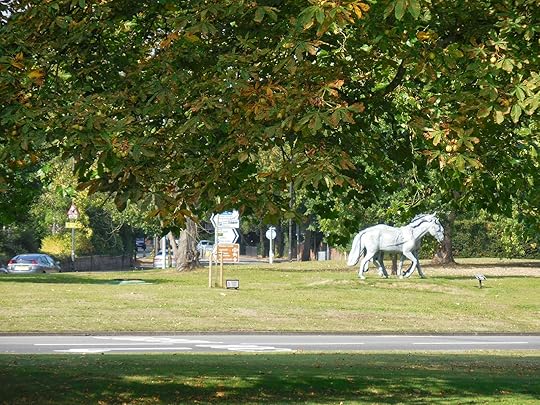
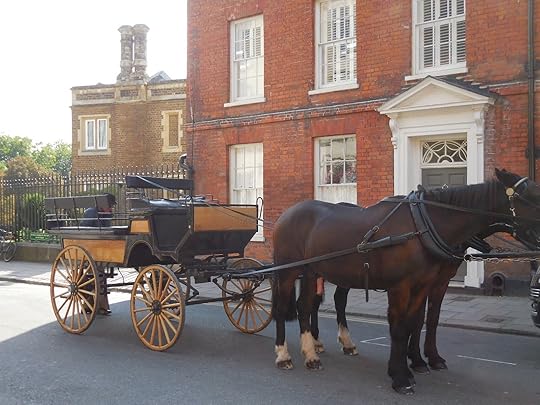

Seen in the Mall

Above and below - In the Royal Mews

From our vantage point atop the Wellington Arch









As seen at Horseguards








At Osterley Park









STRATFIELD SAYE





IN WINDSOR







Published on March 13, 2016 23:30
March 11, 2016
POST TOUR: BEN FRANKLIN'S HOUSE
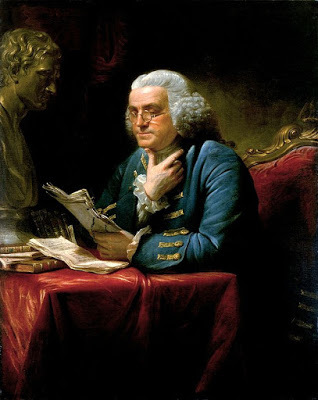 Benjamin Franklin 1706-1790
Benjamin Franklin 1706-1790Though he was born in Boston in the colony of Massachusetts and lived much of his life in Philadelphia, Pennsylvania, Franklin's only remaining intact residence is found at 36 Craven Street, London. We were astonished to find it almost in the shadow of the huge Charing Cross Station in a street of Georgian terraced houses.
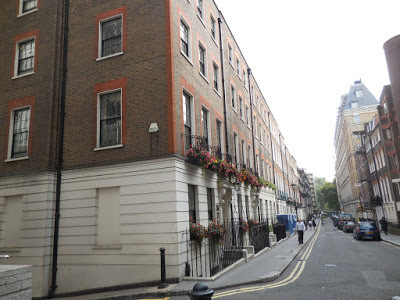
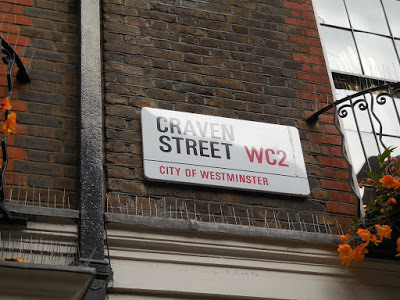
Although most of London looks very different in the 21st century, one comes upon these Georgian streets in several neighborhoods. We hope they are preserved forever.
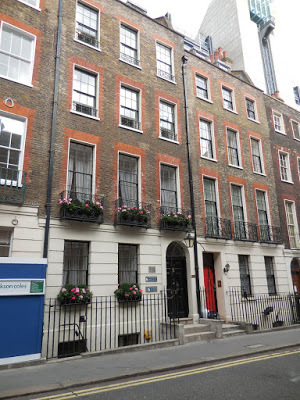
\
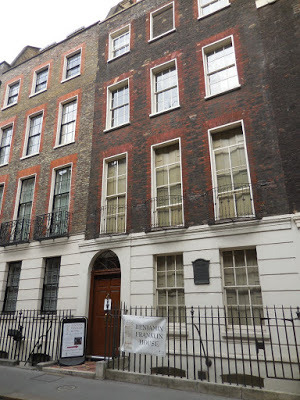 Ben Franklin's House
Ben Franklin's House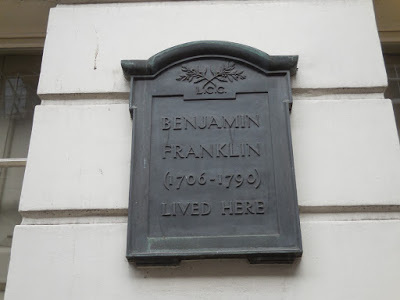
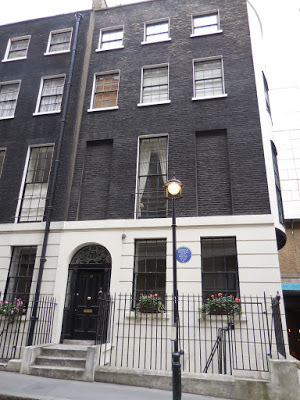 At the end of the block is a building which also housed a famous American.
At the end of the block is a building which also housed a famous American.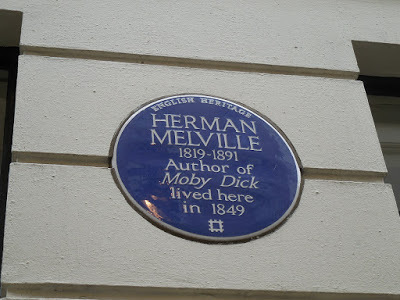 Herman Melville
Herman Melville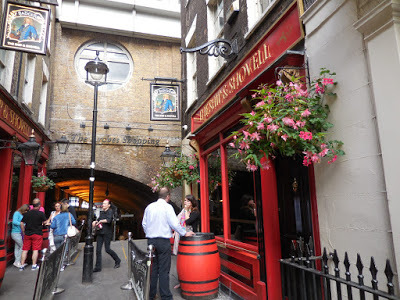 And around the corner, beyond the Pubs, is the tunnel into Charing Cross station.
And around the corner, beyond the Pubs, is the tunnel into Charing Cross station.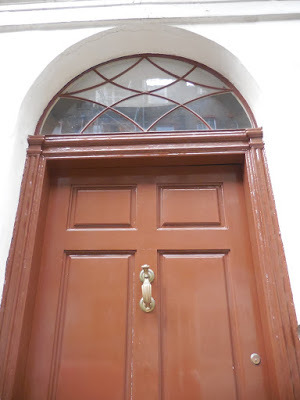 Door of #36 Craven Street
Door of #36 Craven Street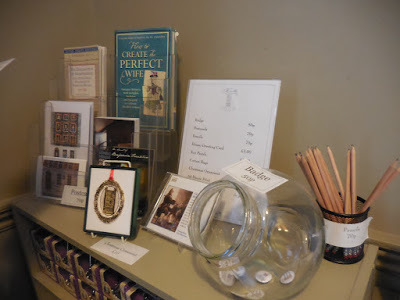
Entering Ben Franklin's House...
From the text panel on The Enlightenment:
"The Enlightenment was a philosophical movement that saw scientific and rational thought triumph over traditional beliefs. Its impact was felt in many areas that together led to great change and progress. ... Benjamin Franklin's profession as a printer was central to the Enlightenment's success spreading its message widely....for nearly sixteen years, between 1757 and 1775, Franklin at 36 Craven Street was an active part of the Enlightenment. It flourished in the coffee houses, salons, and private homes around London, where writers and thinkers met to discuss ideas. In this very house, which served as the first de facto American Embassy, Franklin debated social and political reform, invention and scientific progress with the best minds of the British Enlightenment."
The Benjamin Franklin House website is here.
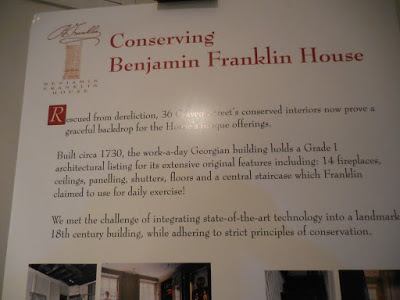
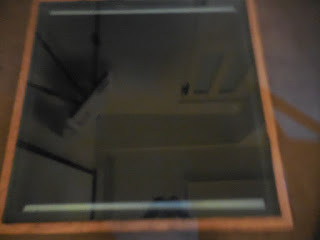 Many artifacts are shown, particularly Franklin's glasses (he invented bifocals for reading), printer;'s tools, and medical equipment.
Many artifacts are shown, particularly Franklin's glasses (he invented bifocals for reading), printer;'s tools, and medical equipment.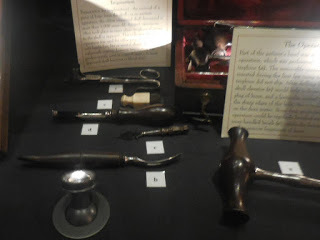
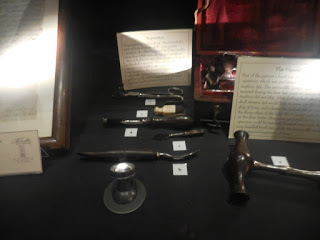
The tour through the house takes visitors from room to room, with explanations of the architecture, furnishings of the rooms, and visuals projected on the walls. Not only does one learn about Franklin and his life and times, but the bones of the house itself are revealed in all their elegant Georgian simplicity.
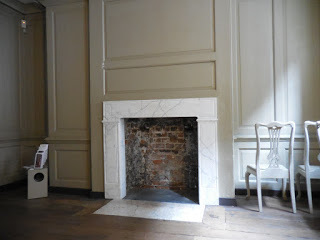
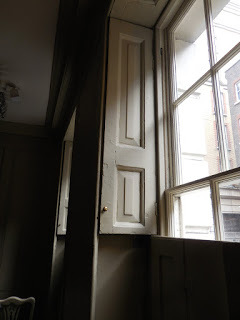
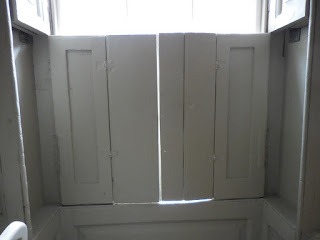
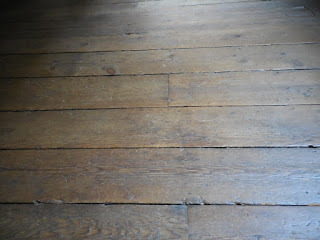
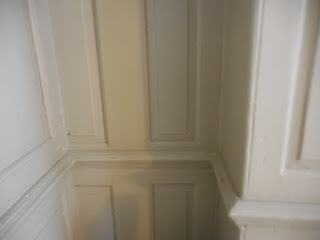
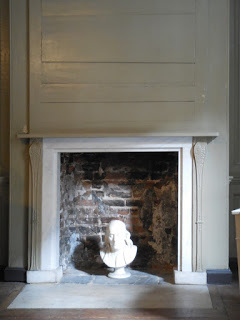
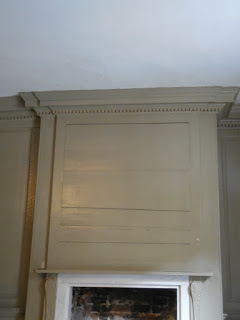
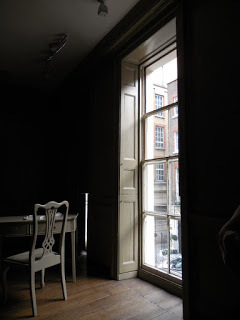
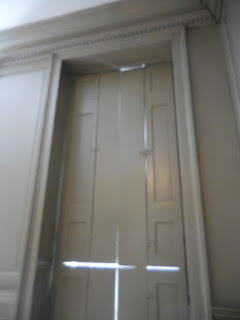
Upstairs, is n example of a musical instrument Franklin invented, the glass armonica (or harmonica), for which Mozart and Bach composed, among others. It plays beautifully with a ringing clarity and has been used over the centuries in various orchestral works.
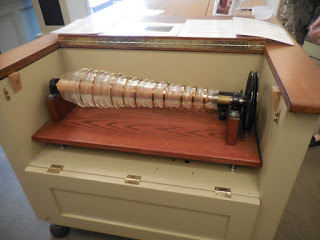
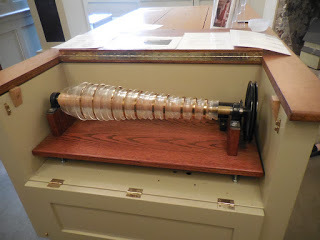
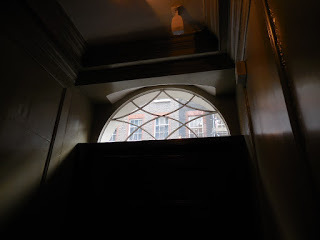
The accounts of Ben Franklin's life in London, his relationship with his landlady's family, and his position in society are well covered, even for American visitors who are more familiar with his life than most British school children. Or at least one would hope so!
The program is creative and imaginative. How anyone cannot come away with many more questions about this fascinating man was beyond our ken! Well worth a visit when you are next in London.
More about Franklin to come.
Published on March 11, 2016 00:00
March 8, 2016
ONCE AGAIN WEDNESDAY - WHAT IS AN ORANGERY?
With this post we're instituting Once Again Wednesdays, whereby we republish some of our most popular posts and reader favourites.
What is an Orangery? by Victoria Hinshaw - Originally published in April 2010
Since the first purposeful cultivation of plants, humankind has struggled to improve growing conditions by altering the environment. For the plant to thrive, is it too cold? Too dark? Too rainy? Too arid? Too windy? How can the plant's living arrangements be improved to give it maximum light, water, air circulation and fertility? How can we improve on Mother Nature?
Below, inside the Orangery at Saltram House, Plymouth, Devon.
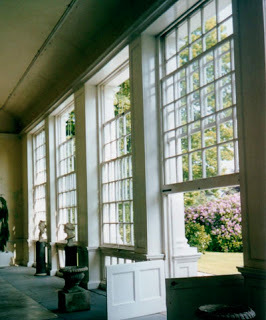 Today we take for granted the cultivation of fruits, vegetables, herbs and flowers in computer-monitored locations that bring us year-round production, the result of centuries of experimentation and invention. Two hundred years ago, our ancestors knew what was needed for maximum production, and they were quickly developing the technological requirements for success.
Today we take for granted the cultivation of fruits, vegetables, herbs and flowers in computer-monitored locations that bring us year-round production, the result of centuries of experimentation and invention. Two hundred years ago, our ancestors knew what was needed for maximum production, and they were quickly developing the technological requirements for success. To some extent, the terms greenhouse, glasshouse, hothouse, orangerie, pinery, and conservatory can be used interchangeably, though each has a generally agreed upon specific meaning. All these terms and the buildings they describe existed in Georgian England, mostly at royal palaces and the estates of the wealthy aristocracy.
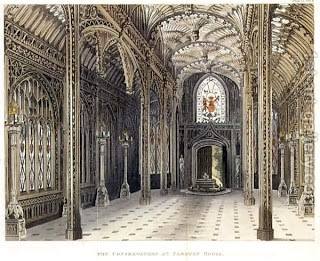 The Regency era, whether one confines the definition strictly to 1811-1820 or, more broadly, the French Revolution to Victoria 1789-1837, was truly a time of transition in enhanced plant cultivation indoors.
The Regency era, whether one confines the definition strictly to 1811-1820 or, more broadly, the French Revolution to Victoria 1789-1837, was truly a time of transition in enhanced plant cultivation indoors. At Carlton House, the Prince of Wales' London residence (demolished in 1826-27), a conservatory was added in 1807 in the newest construction techniques in cast iron columns and a fan vaulted ceiling supporting large glass spaces. The architect was Thomas Hopper (1776-1856) whose work was considered a tour de force. The conservatory opened into the gardens at one end. If one looked in the opposite direction, there was a clear view of the entire lower ground-floor range of rooms.
The Carlton House conservatory was intentionally theatrical, as some writers observed, bringing the term "elaborate" to a new level. The Prince Regent planned a great fete for 2,000 people on June 19, 1811, to celebrate his Regency. Down the middle of the 200-foot length of the table ran a curving stream of water lined with flowers, mossy banks and crossed by miniature bridges. Goldfish swam up and down this tiny stream. Here is the account by John Ashton in Social England Under the Regency (1895) of the Prince Regent's conservatory and the party: "...the architecture of it is of the most delicate Gothic. ...In the front of the Regent's seat there was a circular basin of water, with an enriched Temple in the centre of it, from whence there was a meandering stream to the bottom of the table, bordered with green banks. Three or four fantastic bridges were thrown over it, one of them with a small tower upon it, which gave the little stream a picturesque appearance. It contained also a number of gold and silver fish. The excellence of design, and exquisiteness of workmanship could not be exceeded; it exhibited a grandeur beyond description; while the many and various purposes for which gold and silver materials were used were equally beautiful and superb in all their minute detail.”
Existing watercolors of the conservatory by Charles Wild (1781-1835), who painted many views of Carlton House, do not show any plants placed to take advantage of the overhead light provided by the glass and iron fan vaulting. These watercolours were published by Rudolph Ackermann in his Repositories of the Arts, beginning in October 1819. The watercolors of Carlton House and other royal residences were re-issued in 1984 by The Vendome Press, ISBN 0-86565-048-9. In Regency Design, however, Steven Parissien shows a view of the Prince Regent's conservatory with extensive planting along the sides p. 218; also in Morley, p. 787). He also notes that the structure leaked badly and quotes Nash in 1822, "the glazed vaulting was 'worse than useless as a roof' and recommended replacing it with plaster." Leaks or no leaks, Prinny's conservatory was, as he wished, a trend-setter.
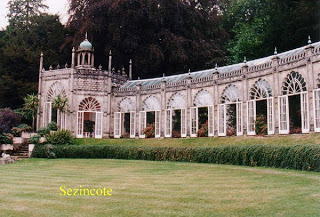
The fanciful orangery at Sezincote, in the Gloucestershire Cotswolds, inspiration for the Brighton Pavilion. Visit Sezincote.
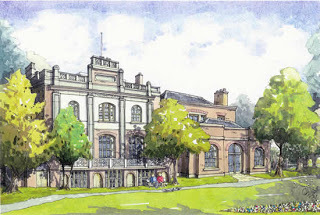 A more modest conservatory was built by the renowned regency architect Sir John Soane at his country home Pitshanger Manor, in Ealing, a suburb of London. Mavis Batey writes, "The breakfast room opened on to a conservatory, which ran the length of the building, with sash windows to the floor, partly of coloured glass. Soane described it as 'enriched with antique cinerary urns, sepulchral vases, statues...vines and odiferous plants; the whole producing a succession of beautiful effects, particularly when seen by moonlight, or when illuminated and the lawn enriched with company enjoying the delights of cheerful society.'" Despite the difference in scale, it is clear that the conservatories at Carlton House and Pitshanger Manor shared a common element: they were used for entertainment and socializing.
A more modest conservatory was built by the renowned regency architect Sir John Soane at his country home Pitshanger Manor, in Ealing, a suburb of London. Mavis Batey writes, "The breakfast room opened on to a conservatory, which ran the length of the building, with sash windows to the floor, partly of coloured glass. Soane described it as 'enriched with antique cinerary urns, sepulchral vases, statues...vines and odiferous plants; the whole producing a succession of beautiful effects, particularly when seen by moonlight, or when illuminated and the lawn enriched with company enjoying the delights of cheerful society.'" Despite the difference in scale, it is clear that the conservatories at Carlton House and Pitshanger Manor shared a common element: they were used for entertainment and socializing.Greenhouses have ancient sources. The Romans, adept at channeling the waters and building for maximum comfort, had many schemes to enhance growing conditions for plants of all kinds. The Roman emperor Tiberius had a sort of greenhouse, called a Specularium, created with mica in small translucent flakes where we would today have glass. Tiberius, it is reported, needed a year-round supply of his favorite food: cucumbers! Further developments in specularia included ducts carrying hot water or cool air, typical of Roman engineering. Among the plants grown in these mica-roofed structures were grapes, peaches and roses.
Orangeries can be seen at many English country houses and on the grounds of several royal palaces im Britain, as well as throughout Europe. Below, the orangery at Belton House, Lincolnshire
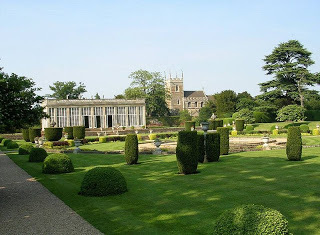
A primary motivation for the improvement of greenhouse design was the English penchant for the collection and study of botanic material from all over the globe. The earliest explorers brought back seeds and exotic species. The damp, chill English climate needed some alteration if these new species were to survive and flourish.
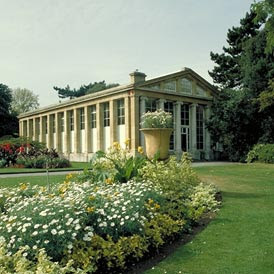
Kew Gardens (officially the Royal Botanic Gardens at Kew) originally belonged to the royal family. Frederick, Prince of Wales, (son of George II and father of George III) and his wife, Princess Augusta, had a great interest in exotic plants. Their collection is the core of today's 40,000 varieties of plants at Kew. None of Kew's hothouses survive from the Georgian period. One regency-era building, the Nash Conservatory, was built at Buckingham Palace in the design of a Greek temple; it was moved to Kew in 1836. Recently fully restored, the Nash Conservatory is used now as a school education center.
By the middle of the 19th century, the popularity of greenhouses had grown exponentially. What's more, materials became less expensive and more readily available, so greenhouses and growing plants under glass were no longer a pastime only of the wealthy. Small greenhouses and conservatories of many designs were added to middle class Victorian houses. There was also competition by cities and countries to build conservatories as part of grand public parks. These housed exotic, non-native plants as well as common varieties, and remain popular today.
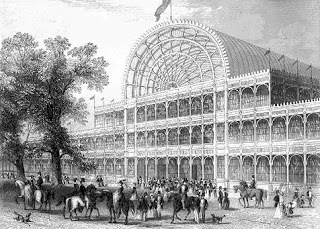 One of the most famous glass buildings in the world was the Crystal Palace, built in London in 1850-51 for the Great Exhibition. Chief architect was Joseph Paxton (1803-65), former gardener to the sixth Duke of Devonshire (the Bachelor Duke). It contained all kinds of exhibits, not only plants. Nonetheless, the design of the Crystal Palace influenced decades worth of greenhouses and conservatories, including the many you can order for your home today.
One of the most famous glass buildings in the world was the Crystal Palace, built in London in 1850-51 for the Great Exhibition. Chief architect was Joseph Paxton (1803-65), former gardener to the sixth Duke of Devonshire (the Bachelor Duke). It contained all kinds of exhibits, not only plants. Nonetheless, the design of the Crystal Palace influenced decades worth of greenhouses and conservatories, including the many you can order for your home today.For her help in finding some interesting sources on this subject, special thanks to Jo Manning.
Among the sources used for this post are:Batey, Mavis, Regency Gardens, Shire Garden History, 1995, ISBN 0-7478-0289-0.Hobhouse, Penelope, Gardening Through the Ages, New York: Simon & Schuster, 1992, ISBN 0-671-72887-3.Parissien, Steven, Regency Style, Washington, D. C.: The Preservation Press, 1992, ISBN 0-89133-172-7Rogers, Elizabeth Barlow, Landscape Design: A Cultural and Architectural History, New York: Harry N. Abrams, Inc. Publishers, 2001, ISBN 0-8109-4253-4.
Published on March 08, 2016 23:30
March 6, 2016
THE DUKE OF WELLINGTON TOUR: SELFIES
One of the silliest things I did on the tour was to take selfies with Diane Perkins and/or Denise Costello. Admittedly, they are not up to Kardashian caliber, but they were a lot of fun to take. Here, for your enjoyment, are a few of our faves.
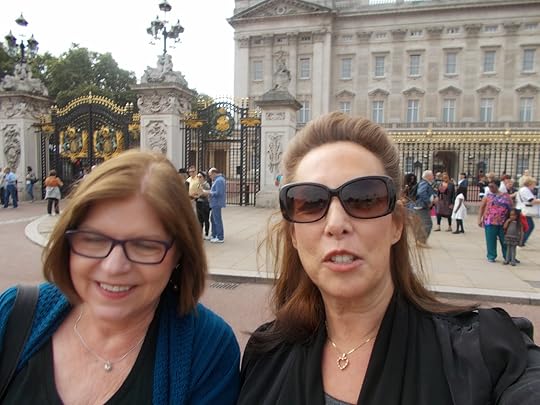
At the Palace with Diane
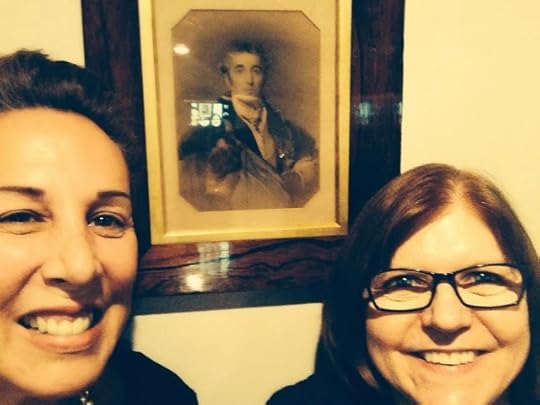
With the Duke of Wellington at the Duke of Wellington Pub
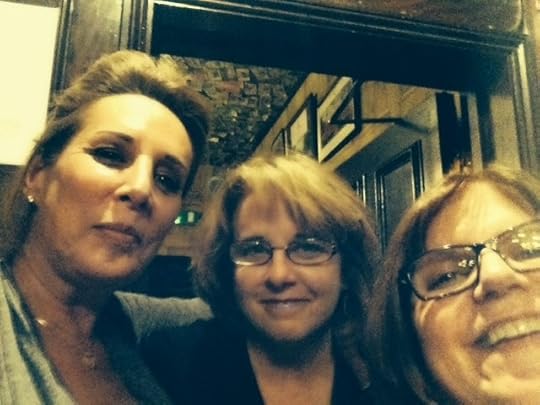
At the Grenadier Pub with Denise and Diane
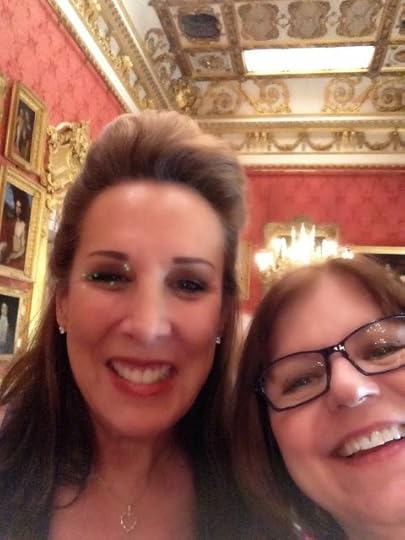
Diane and Kristine at Apsley House
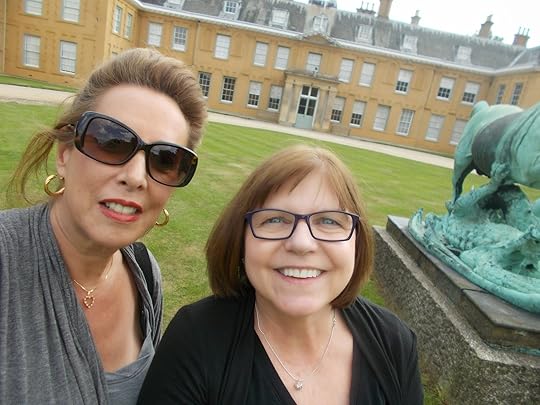
Smiling at Stratfield Saye
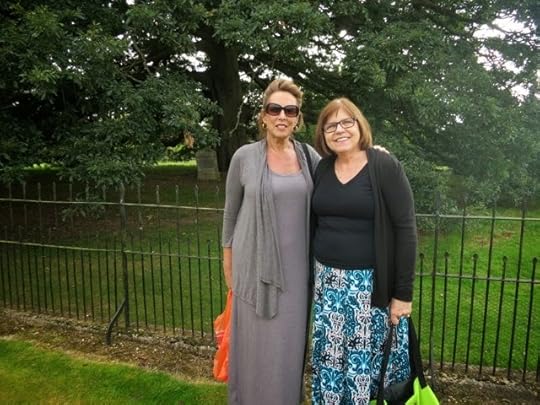
At Copenhagen's Grave, Stratfield Saye

On the Coach

At Windsor Castle
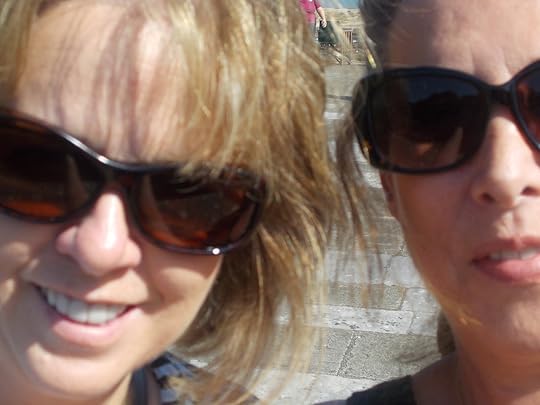
Denise and Kristine at Walmer Castle
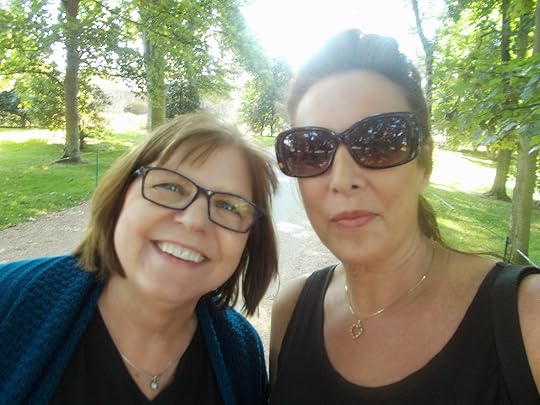
Walmer Castle
Diane and I had so much fun taking selfies in England that we've decided to go back for another round in May. For better or for worse, prepare yourself for selfies from London, Derbyshire and Brighton as we head over to plan the next three tours we'll be offering. Stay tuned for dates and details coming soon!
Published on March 06, 2016 23:30
March 4, 2016
WHAT KRISTINE AND VICTORIA SAW FROM THEIR SIDEWALK TABLE AT THE SHERLOCK HOLMES PUB

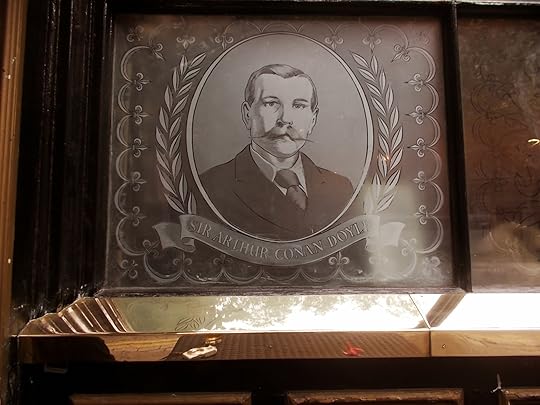





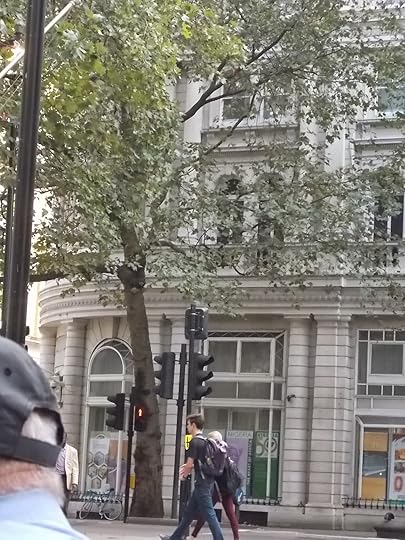

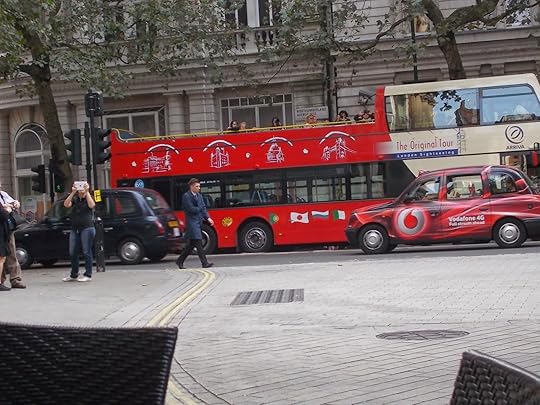



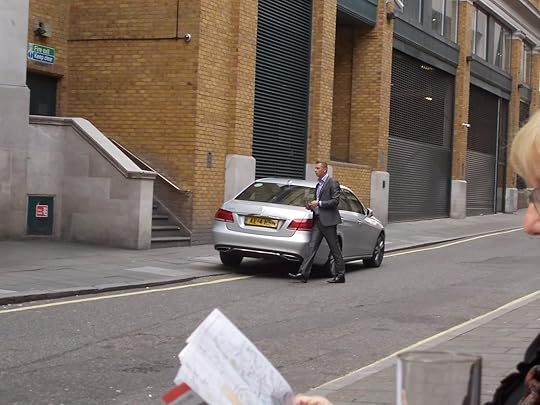







Don't cha wonder how many pictures we appeared in, sitting outside at the Sherlock Holmes...snapped by hundreds of passing tourists?
OMG, Vicky - I was just editing this post prior to publishing and thinking the exact same thing!

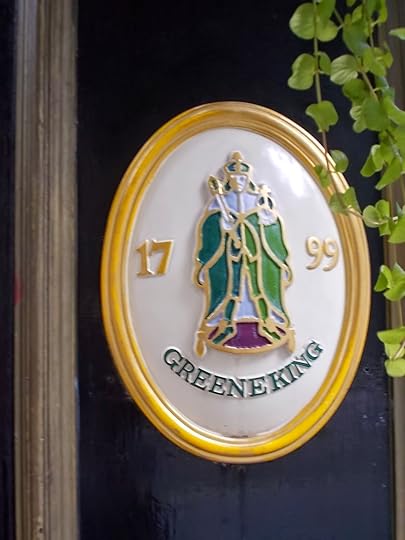
Published on March 04, 2016 00:00
March 1, 2016
VIDEO WEDNESDAY: VICTORIAN SERVANTS - THE REAL STORY
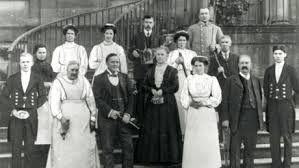
Servants:The Real Story of Life Below Stairs(one hour)
With Downton Abbey incorporating the breakdown of the old order of the ruling class versus the servant class in its' final season, we thought we'd run this documentary which addresses the social and economic changes that lead to the decline of the servant classes, their impact upon those in service and the new opportunities that became available to all and lead to the final farewell to a class system that had existed for centuries.
A century ago, 1.5 million British people worked as servants – astonishingly, more than worked in factories or farms. But while servants are often portrayed as characters in period dramas, the real stories of Britain’s servants have largely been forgotten. Presented by this documentary - herself the great-granddaughter of servants - this three-part series uncovers the reality of servants’ lives from the Victorian era through to the Second World War.
This documentary begins in the grand houses of the Victorian ruling elite – large country estates dependant on an army of staff toiling away below stairs. The Victorians ushered in a new ideal of servitude - where loyal, selfless servants were depersonalized stereotypes with standardised uniforms, hairstyles and even generic names denoting position.
In the immaculately preserved rooms of Erddig in North Wales, portraits of servants like loyal housekeeper Mrs Webster hint at an affectionate relationship between family and servants, but the reality for most was quite different. In other stately homes, hidden passages kept servants separate from the family - anonymity, invisibility and segregation were a crucial part of their gruelling job - and the strict servant hierarchy even kept them segregated from each other.
But it wasn’t just the aristocracy who had servants. The emerging middle classes were also hiring, and thousands – like manservant William Tayler - flocked from the countryside to take up positions in the cities’ townhouses. With no experience of keeping servants, however, how would these anxious new mistresses fair as managers – especially in the wake of a servant scandal? With a plethora of jobs available, the power was not always with the mistress, but also with the maids who were free to leave - and leave they did.
Watch the video here (one hour)
Published on March 01, 2016 23:30
February 28, 2016
DO YOU KNOW ABOUT: JAMES LEES-MILNE?
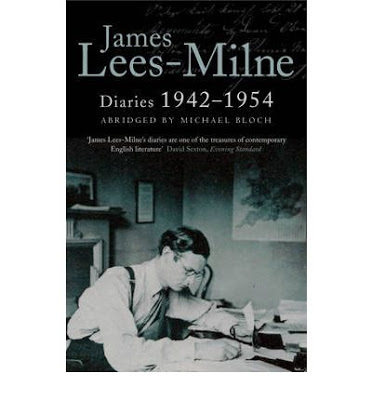
As some of you may already know, I am a great reader of British diaries, letters and journals. There are many such volumes on the shelves of my personal library. From Pepys to Queen Victoria, I adore the immediacy of these personal writings, the way they drop you right into the lives of their authors and introduce you in a very intimate manner to people, places and times otherwise vanished. Recently, I came across the diaries of James Lees-Milne, which had somehow managed to escape my notice over the past few decades. JML was in at the very beginnings of the National Trust and the Georgian Society, amongst other things, and was advisor to the National Trust on which properties should be purchased and preserved by that body. In this capacity, JML travelled around the UK, poking his nose into a variety of stately homes and writing down for posterity his views on their architectural merits, their contents and their owners, often with wit and sometimes with chagrin, but always in a way that can't help but to amuse the reader. In addition, JML lived in London and spent much of the 1930's and 1940's mixing with the Bright Young Things, various celebrities and writers and members of the Royal Family. No doubt you'll appreciate that all of this makes for great fodder in the diary of someone who had a keen observational eye and a talent for first person prose. To read more about the accomplishments of James Lees-Milne, you will find the 1997 obituary that ran in The Independent here.
You'll understand when I tell you that I was prepared to like these Diaries before I'd read Page 1, but I wasn't prepared to find that so many of the entries would resonate with me on a personal level.
Tuesday, 17th February, 1942
Dined with Harold Nicolson and Jamesey at Rules. We talked about Byron's sex life . . . .
Do you mean to say that other people sit around various London venues discussing the sex lives of dead people? Granted, in my circle we tend to focus on Brummell's sex life, but close enough, what? And then there's this entry -
Wednesday, 13th October, 1948
This evening I dined with the John Wyndhams. . . . After dinner, when the women left, talk was about how little we know of the everyday life of our ancestors in spite of George Trevalyan's history. Jock Colville suggested we ought to go home tonight and write down in minute detail how we drove to the Wyndham's door, left our car at the kerb, its doors firmly locked, rang the bell, were kept waiting on the doorstep, how we were received by a butler wearing black bow tie instead of white, what the hall smelt like, how the man took our coats and hats, putting them on a chest downstairs, and how he preceded us upstairs, one step at a time, etc., etc.
Positively uncanny. How often have myself and my friends, many of whom are writers of historical novels, lamented this very same thing and had almost the exact same discussion? By this time I was finding the diaries so delicious that I had to call Victoria immediately.
"Hello."
"Have you ever heard of James Lees-Milne? You must start reading him now. He's our new best friend. Where has he been all of our lives? How could either of us not known about his existence before now?"
"Who?"
"James Lees-Milne. The National Trust guy. Friends with everyone, including the Mitfords. He and his friends used to sit around discussing Byron's sex life."
"James who?"
"Hang up. I'm emailing you the link to his Diaries now. On Kindle. Buy them."
Of course, not all of the Diary entries are about such musings. As I've said, JML lived in London during this period and there is much to be found about the City, especially during wartime. Again, they resonated with me because much of JML's London incorporates my London, i.e. the areas and places in London that I revisit and in which I feel most at home.
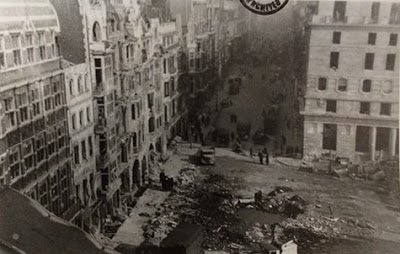
Bomb damage in Pall Mall/St James's Street, February 1944
Thursday, 24th February, 1944
There is no doubt our nerves are beginning to be frayed. Frank telephoned this morning. I could tell by his voice he was upset. He said he was going to leave the Paddington area and thought Chelsea or Belgravia would be safer. I said I doubted whether the Germans discriminated to that extent. This evening I went to see a crater in the road, now sealed off, in front of St. James's Palace. The Palace front sadly knocked about, the clock awry, the windows gaping, and shrapnel marks on the walls. A twisted car in the middle of the road. . . In King Street Willis's Rooms (Almack's) finally destroyed, one half having gone in the raid of (May) 1941 when I was sheltering in the Piccadilly Hotel.
Sunday, 18th June, 1944
At Mass at 11 there was a great noise of gunfire and a rocket. In the afternoon Stuart walked in and said that a rocket had landed on the Guards' Chapel (Wellington Barracks) during service this morning, totally demolishing it and killing enormous numbers of Guards officers and men. Now this did shake me. After dining at the Churchill Club we walked through Queen Anne's Gate, where a lot of windows with the old crinkly brown glass panes have been broken. In St. James's Park crowds of people were looking at the Guard's Chapel across Birdcage Walk, now roped off. I could see nothing but gaunt walls standing, and gaping windows. No roof at all. While I watched four stretcher-bearers carried a body under a blanket, a (air raid) siren went, and everyone scattered. I felt suddenly sick. Then a rage of fury against the war raged inside me. For sheer damnable devilry what could be worse than this terrible instrument?
To think that Gunter's and Almack's had managed to survive until the War. In fact, JML was a patron of Gunter's -
Saturday, 16th June, 1945
This morning the telephone man came to Alexander Place to say he would install my telephone on Monday . . . the bath however is still unattached to the pipes. The house painter and I picnic together. I leave the house each morning at 7.30 to bathe, shave and breakfast at Brooks's, where I virtually live. In Heywood's shop I met Diana (nee Mitford) Mosley and Evelyn Waugh with Nancy (Mitford). I kissed Diana who said the last time we met was when I stayed the night in Wootton Lodge, and we both wept when Edward VIII made his abdication broadcast. I remember it well, and Diana speaking in eggy-peggy to Tom Mosley over the telephone so as not to be overheard. . . . We all lunched together at Gunter's. . . .
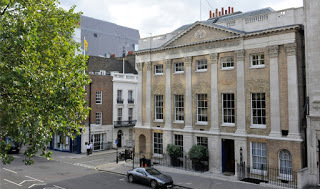 Brooks's Club, St. James's Street
Brooks's Club, St. James's StreetLees-Milne stirs the heartstrings of every Anglophile with this entry -
Saturday, 17th June, 1944
Worked in Brooks's library this afternoon. I am always happy in this stuffy, dingy Victorian library, in which the silence is accentuated by the relentless ticking of the old, stuffy clock.. I love the old stuffy books on the stuffy brown shelves, books which nobody reads except Eddie Marsh, and he falls fast asleep over them. The very atmosphere is calculated to send one asleep, but into the gentlest, most happy, nostalgic dreams of ninetheenth-century stability, self-satisfaction and promise of an eternity of heavenly stuffiness, world without end. How much I adore this library, and club, nobody knows. May it survive Hitler, Stalin and all the beastliness which besets us.
As I said, JML travelled the length and breadth of the UK both for his National Trust work and in order to visit various friends and relations. His entries concerning the Duke of Wellington were of particular interest, especially as they illustrate the consequences which the burden of caring for the first Duke's belongings could bring about -
Saturday, 15th April, 1944
I caught the 1.15 to Reading where Gerry Wellington met me at the station in his small car, for he gets twenty gallons a month for being a duke. . . the western front of Stratfied Saye house clearly shows it to date from Charles I's reign . . . . the east front is not so regular as the west, and the terraces are deformed by messy Edwardian flower beds. Gerry, who hates flowers, will soon have them away . . . Having eaten little luncheon I was famished, but tea consisted of only a few of the thinnest slices of bread and butter imaginable. After tea we did a tour of the inside of the house, beginning with the hall. When my stomach started to rumble with hunger Gerry looked at it with a reproachful air, and said nothing. It went on making the most awful noise like a horse's. The hall has a gallery along the wall opposite the entrance. The open balusters were boxed in so as to prevent the servants being seen from below by the visitors. Gerry's mother used to say that nothing of them was visible except their behinds, as they crouched and bobbed across the gallery. . . . the dining room is shut up, all the Apsley House pictures being stored there for the war, and valued at a million pounds, so G. says. . . . After dinner, at which there were no drinks except beer, (Gerry) showed me his grandfather's collection of gems and intaglios, mounted on long, gold chains. When held against the oil lights, some of the stones were very beautiful. G. is very fussy over the key bunches, everything being carefully locked up. He has a butler, cook and two housemaids, and a secretary, Miss Jones. The last has meals with him during the week, and nearly drives him mad with her archness. `Aren't you naughty today?' she says. She is unable to type, so when he wishes to dispatch a letter not written by himself, he types it and gives it to her to sign.
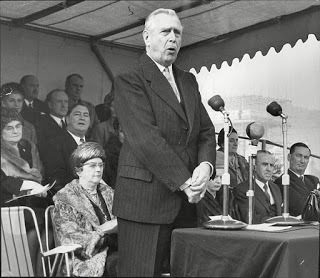 Gerald Wellesley, 7th Duke of Welligtonand
Gerald Wellesley, 7th Duke of WelligtonandSunday, 26th June, 1948 (at Stratfield Saye)
Lady Hudson and Lady Granville came to tea, and Lady G. suddenly developed St. Vitus's dance and jangled the cup in her saucer, spilling scalding tea through a thin silk dress on to her knees, and smashing the saucer to smithereens. Gerry leapt up, seized the table upon which a few drops of the tea had sprinkled and rushed away with it to have the surface polished. He made not a gesture of help or sympathy to poor Lady Granville who was in considerable pain and distress. Typical Gerry behaviour. He never lets one down. His patent anxieties about his possessions bring these catastrophes about . . . . .
Below are just three more examples of JML's entries on stately homes that afford us an insight onto a bygone way of life -
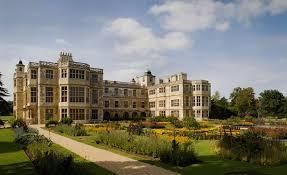
Thursday, 4th May, 1944
Martineau and I lunched at the Hyde Park Hotel with Lord Braybrooke, who has recently succeeded two cousins (killed on active service), inheriting the title and Audley End (House, Essex). He is a bald, common-sensical, very nice business man of 45, embarrassed by his inheritance. At his wit's end what to do with Audley End. Who wouldn't be? It was arranged that Martineau and I would visit the house with him in June. It is requisitioned by the Army and used for highly secret purposes, so that even he is not allowed into the rooms except in the company of a senior officer. Consequently he hardly knows the way round his own house. . . .
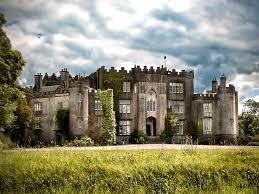
Saturday, 25th August, 1945
Describing a journey to Birr Castle - I woke at 5.45 and at 6.45 the car ordered by Michael Rosse called for me. It picked him up in Mount Street and drove us to Euston for the 8.15 to Holyhead. Travelled in comfort and ease. . . . After a smooth crossing we reached Kingstown at 7.30. I was at once struck by the old-fashioned air of everythng: horse-cabs on the quay, cobbled streets with delicious horse-droppings on them. Met by a taxi come all the way from Birr, for 8 pounds. Letter of greeting from Anne to Michael. Vodka for Michael and me in the car. We drove straight through Birr. Even through the closed windows of the car I caught the sweet smell of peat in the air. Curious scenes, ragged children on horses drawing old carts along country lanes. Our driver sounded his horn loudly through Birr, that pretty, piercing foreign horn. The gates of the castle shop open as if by magic. A group of people were clustered outside the gate. We swept up the drive. All the castle windows were alight, and there on the sweep was a large crowd of employeees and tenants gathered to welcome Michael home from the war. Anne, the two Parsons boys and Mr. Garvie the agent on the steps. Behind them Leavy the butler, the footman, housekeeper, and six or seven maids. A fire blazing in the library and everywhere immense vases of flowers. We heard Michael make a short speech from the steps, followed by cheers and `For he's a jolly good fellow,' a song which always makes me go hot and cold, mostly hot. The crowd then trooped off to a beano and drinks, while we sat down to a huge champagne supper at 11 o'clock.
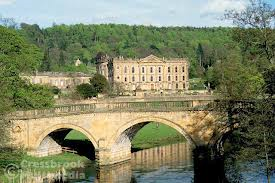
Sunday, 1st August, 1948
Debo and Andrew (Hartington)(later 11th Duke and Duchess of Devonshire) drove me to Chatsworth this morning. The site of the house, the surroundings unsurpassed. The grass emerald green as in Ireland. The Derwent river, although so far below the house, which it reflects, seems to dominate it. Black and white cattle in great herds. . . . We wandered through the gardens, greyhounds streaming across the lawns. Andrew turned on the fountain from the willow tree. Water not only drips from the tree but jets from nozzles all round. The cascade not working this morning, but will be turned on for the public this afternoon. At present the great house is empty, under covers and dustsheets. Next year the state rooms are to be shown . . . As a couple the Hartingtons seem perfection - both young, handsome, and inspired to accomplish great things . . . Both full of faith in themselves and their responsibilities. She has all the Mitford virtues and none of the profanity. I admire them very much.
The Diaries are full of entries that shed light on the many facets to Lees-Milne's personality, from the profound -
Wednesday, 30th November, 1949 (upon the death of his father after a long illness)
The very worst thing about death are the disprespect, the vulgarity, the meanness. God should have arranged for dying people to disintegrate and disappear like a puff of smoke into the air. There are many other scraps of advice I could have given him.
to the stingingly comic -
Sunday, 14th November, 1948
Newman, the hall porter at Brooks's, told me I would be surprised if I knew which members, to his knowledge, stole newspapers out of the Club. I said, `You must not tell me,' so he promptly did.
I urge you, as I urged Victoria, to waste no time in securing yourself a copy of James Lees-Milne's Diaries. Victoria, I'm pleased to say, took my advice and read the Diaries - she loved them, too. Do let me know what you think when you're finished with them.
Published on February 28, 2016 23:30
Kristine Hughes's Blog
- Kristine Hughes's profile
- 6 followers
Kristine Hughes isn't a Goodreads Author
(yet),
but they
do have a blog,
so here are some recent posts imported from
their feed.



